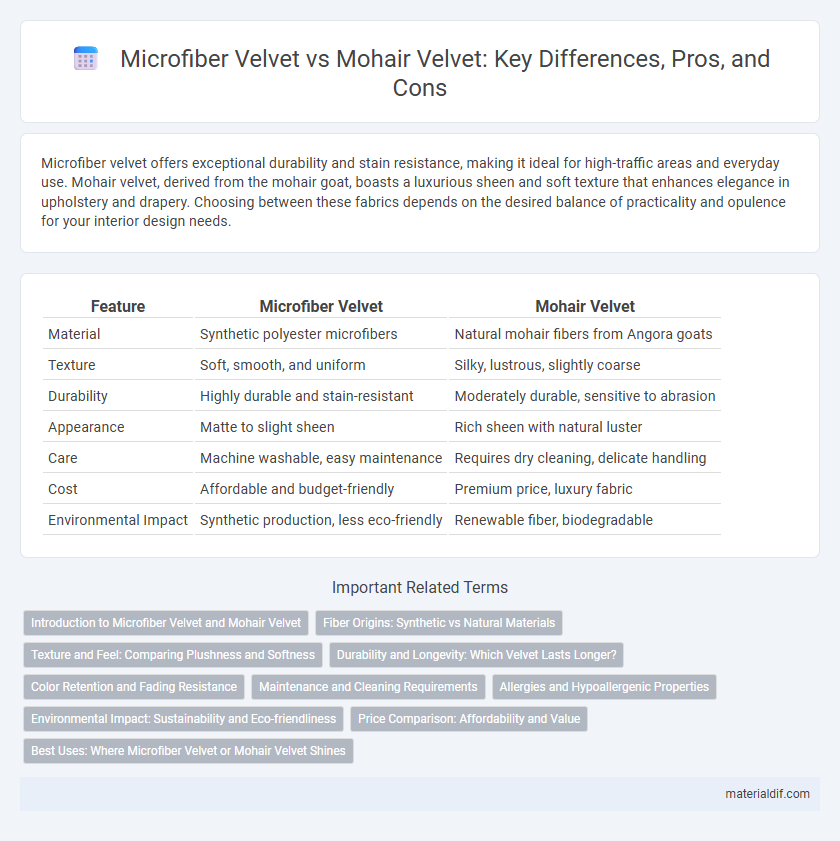Microfiber velvet offers exceptional durability and stain resistance, making it ideal for high-traffic areas and everyday use. Mohair velvet, derived from the mohair goat, boasts a luxurious sheen and soft texture that enhances elegance in upholstery and drapery. Choosing between these fabrics depends on the desired balance of practicality and opulence for your interior design needs.
Table of Comparison
| Feature | Microfiber Velvet | Mohair Velvet |
|---|---|---|
| Material | Synthetic polyester microfibers | Natural mohair fibers from Angora goats |
| Texture | Soft, smooth, and uniform | Silky, lustrous, slightly coarse |
| Durability | Highly durable and stain-resistant | Moderately durable, sensitive to abrasion |
| Appearance | Matte to slight sheen | Rich sheen with natural luster |
| Care | Machine washable, easy maintenance | Requires dry cleaning, delicate handling |
| Cost | Affordable and budget-friendly | Premium price, luxury fabric |
| Environmental Impact | Synthetic production, less eco-friendly | Renewable fiber, biodegradable |
Introduction to Microfiber Velvet and Mohair Velvet
Microfiber velvet is a synthetic fabric made from ultra-fine polyester fibers, offering exceptional softness, durability, and stain resistance ideal for upholstery and home decor. Mohair velvet, derived from the hair of the Angora goat, features natural luster, strength, and a luxurious texture valued in high-end fashion and furnishings. Understanding the differences in fiber origin, texture, and maintenance helps select the perfect velvet type for specific design and functional needs.
Fiber Origins: Synthetic vs Natural Materials
Microfiber velvet is crafted from synthetic fibers such as polyester, offering durability and stain resistance ideal for high-traffic areas. Mohair velvet, derived from the natural hair of the Angora goat, features a luxurious sheen and soft texture prized in premium upholstery and fashion. The distinct fiber origins influence not only the tactile experience but also maintenance requirements and environmental impact of each velvet type.
Texture and Feel: Comparing Plushness and Softness
Microfiber velvet offers a smooth, dense texture known for its durability and stain resistance, providing a soft yet sturdy feel ideal for everyday use. Mohair velvet features a silkier, more luxurious texture with a natural sheen, delivering an exceptionally plush and airy softness prized in high-end upholstery and fashion. The tactile difference lies in microfiber's consistent, velvety nap versus mohair's more delicate and slightly textured surface, influencing overall comfort and aesthetic appeal.
Durability and Longevity: Which Velvet Lasts Longer?
Microfiber velvet offers exceptional durability due to its synthetic fibers, resisting wear, stains, and fading better than natural textiles, making it ideal for high-traffic areas. Mohair velvet, derived from the Angora goat, boasts a luxurious appearance and soft texture but requires more delicate care and is prone to wear over time. For longevity, microfiber velvet typically outlasts mohair velvet, maintaining its vibrant look and structural integrity in everyday use.
Color Retention and Fading Resistance
Microfiber velvet exhibits superior color retention and fading resistance due to its synthetic fiber composition that resists UV exposure and moisture damage. Mohair velvet, derived from natural angora goat hair, offers a rich texture but is more susceptible to fading over time, especially in direct sunlight. Choosing microfiber velvet ensures longer-lasting vibrancy and durability in upholstery and home decor applications.
Maintenance and Cleaning Requirements
Microfiber velvet requires minimal maintenance, as its synthetic fibers resist stains and repel dirt, making it ideal for high-traffic areas. Mohair velvet, composed of natural fibers from the Angora goat, demands more delicate care, including professional cleaning and gentle vacuuming to preserve its texture and sheen. Both fabrics benefit from prompt spot cleaning, but microfiber velvet's durability offers easier, everyday upkeep compared to the specialized maintenance needed for mohair velvet.
Allergies and Hypoallergenic Properties
Microfiber velvet is known for its hypoallergenic properties, making it an ideal choice for individuals with allergies due to its tightly woven synthetic fibers that resist dust mites and allergens. In contrast, mohair velvet, derived from natural goat hair, can trigger allergic reactions in sensitive individuals as it tends to trap pollen, pet dander, and dust more easily. Choosing microfiber velvet over mohair velvet significantly reduces exposure to common indoor allergens, promoting a healthier living environment.
Environmental Impact: Sustainability and Eco-friendliness
Microfiber velvet, made from synthetic fibers like polyester, generally has a lower environmental impact due to its durability and resistance to wear, reducing the need for frequent replacement. Mohair velvet, sourced from the hair of Angora goats, is a natural and biodegradable fabric with a smaller carbon footprint but involves animal farming practices that may raise ethical concerns. Choosing between the two depends on prioritizing synthetic longevity and recyclability versus renewable, biodegradable resources and animal welfare.
Price Comparison: Affordability and Value
Microfiber velvet offers a more affordable option compared to mohair velvet, with prices typically ranging from $10 to $30 per yard, making it ideal for budget-conscious projects without sacrificing softness or durability. Mohair velvet, derived from the Angora goat, commands higher prices between $50 and $150 per yard due to its luxurious texture, durability, and natural sheen, representing a premium investment in quality. Choosing microfiber velvet provides excellent value for upholstery and fashion applications, while mohair velvet delivers unmatched elegance and longevity for high-end designs.
Best Uses: Where Microfiber Velvet or Mohair Velvet Shines
Microfiber velvet excels in high-traffic areas and family-friendly spaces due to its durability, stain resistance, and easy maintenance, making it ideal for upholstery, sofas, and everyday furniture. Mohair velvet, prized for its luxurious sheen and soft texture, is best suited for formal living rooms, accent chairs, and decorative cushions where its elegance can be showcased with less wear and tear. Choosing between microfiber and mohair velvet depends on balancing the need for practicality versus sophistication in interior design.
Microfiber Velvet vs Mohair Velvet Infographic

 materialdif.com
materialdif.com